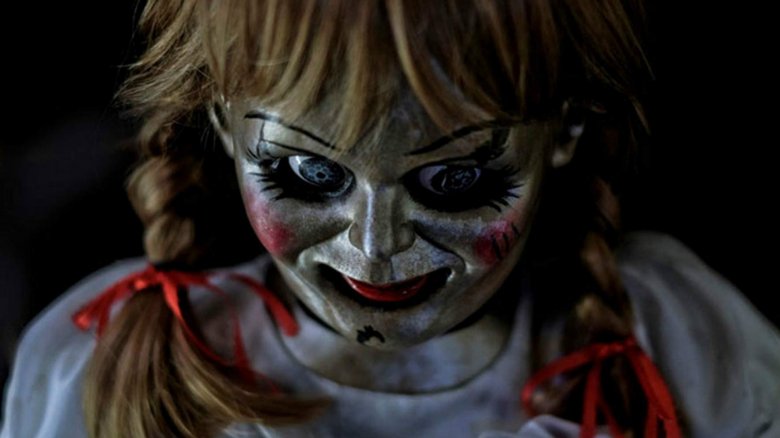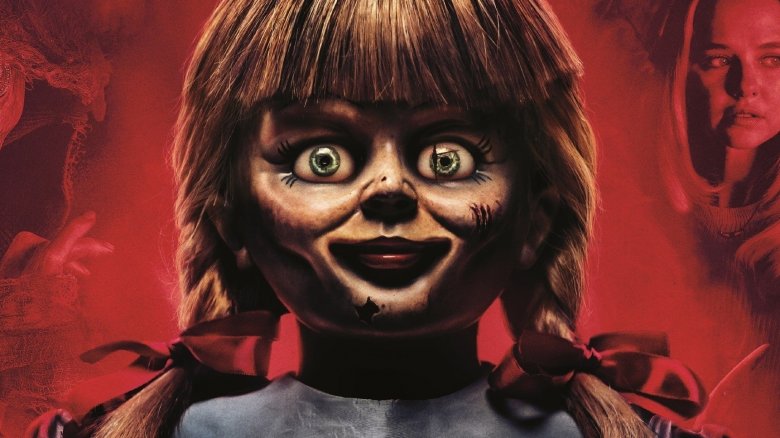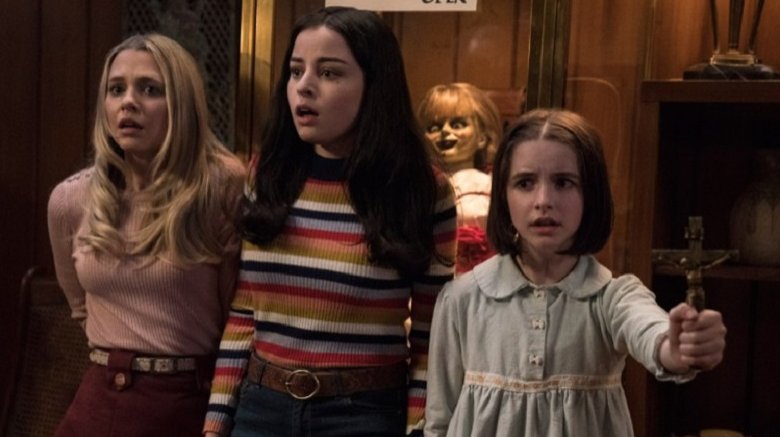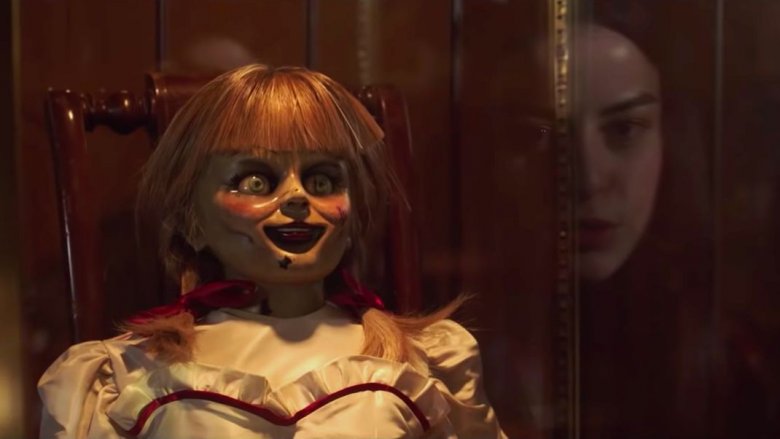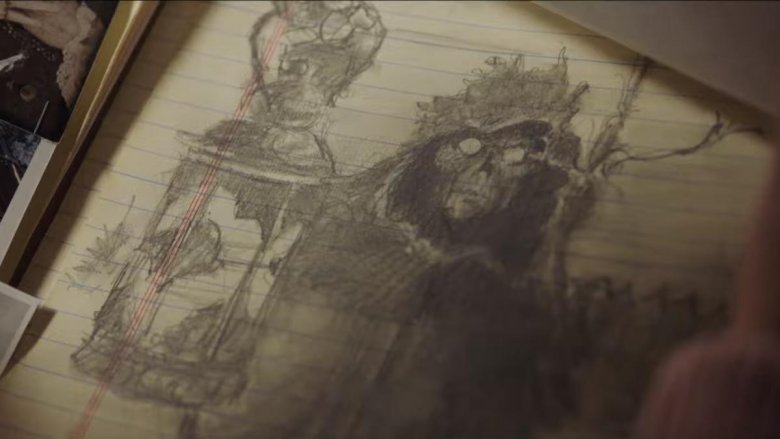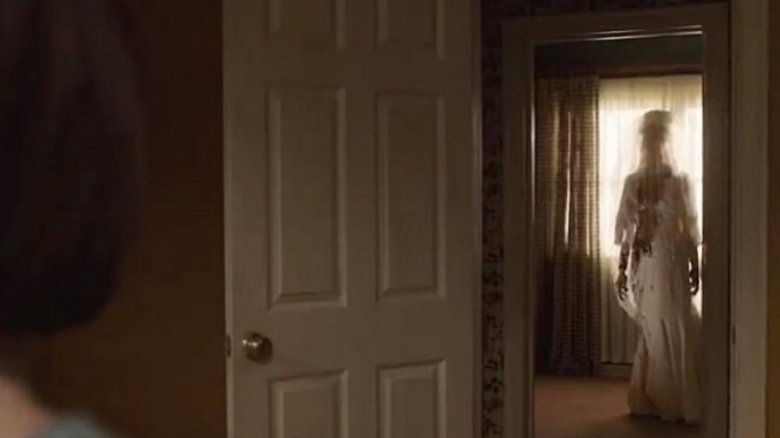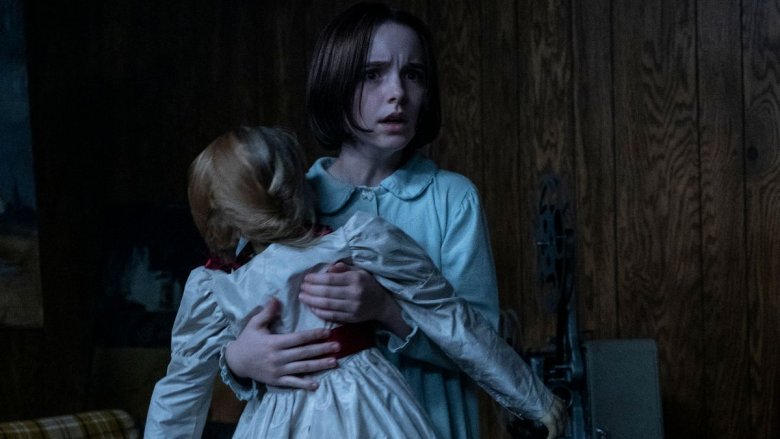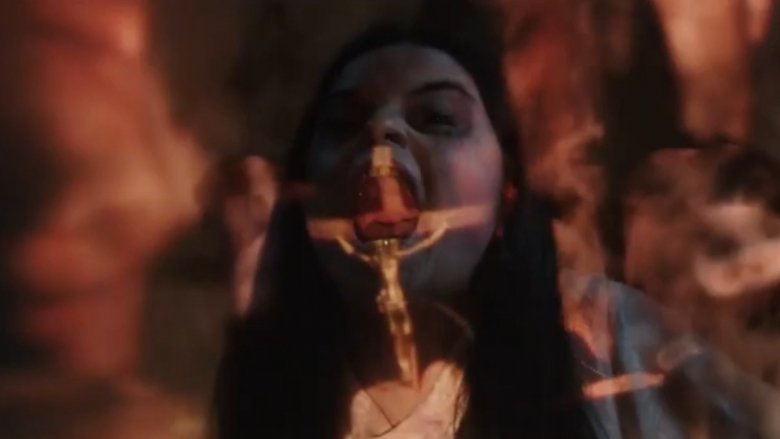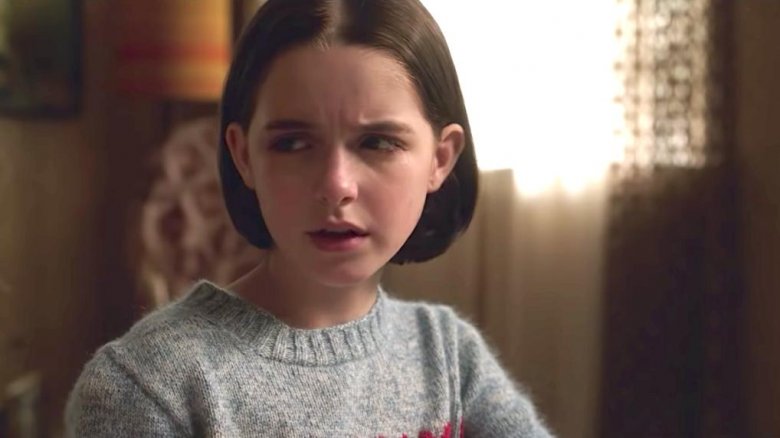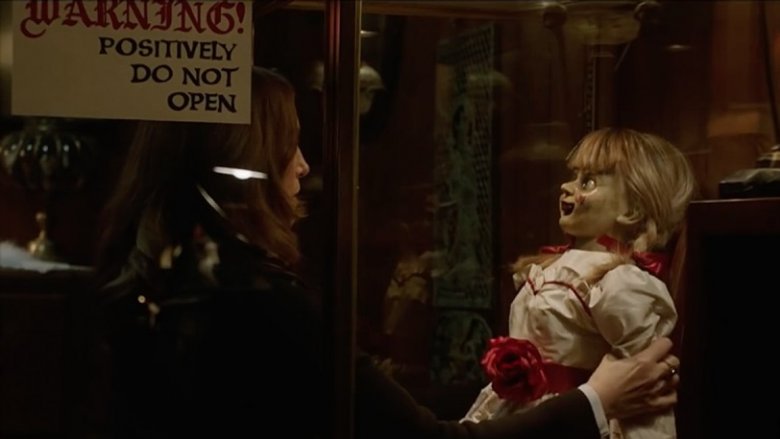The Ending Of Annabelle Comes Home Explained
If you like horror movies that play out like amusement park thrill rides, then you're probably going to love Annabelle Comes Home. In addition to being the third movie in the Annabelle sub-series, this threequel is the seventh film in the wider universe of The Conjuring, that series of horror films tied together by the quote-unquote "case files" of real life paranormal investigators Ed and Lorraine Warren.
In Annabelle Comes Home, the gloves come off of the series' ghosts in a way the franchise has never attempted before. According to James Wan, the prolific producer and director who kicked off the whole Conjuring train in 2013, this universe-expanding feature is "basically A Night at the Museum, with Annabelle." Specifically, it follows the events that happen once the deadly doll's demonic influence is able to wreak havoc in the Warrens' storied artifact room.
As any fan of the series knows, that collection is much bigger than a mere cupboard could contain — the end of this movie almost feels like Storage Wars meets The Walking Dead, with the whole hoard coming alive to kill everyone in sight. If you got lost in the cacophony, here's an explainer for what goes down in the closing minutes of Annabelle Comes Home.
That pesky doll
Before we get into the ending, let's revisit some of the movie's more important details, which you may have missed out on if you got to your seats late. (Or if you're new to the franchise — despite being a sequel many times over, this relatively ambitious monster mash is surprisingly newbie-friendly.)
In case one glance at her over-the-top messed-up mug doesn't tell the whole story, Annabelle is obviously a haunted doll. But the haunting works in a very specific way, leaving her more or less devoid of personality — especially compared to her haunted doll compatriots in the Child's Play and, uh, Toy Story series.
While the doll can inexplicably move around in a way that gives off the impression of possession, Annabelle isn't really a character of her own — she's more like Billy from James Wan's own Saw series, serving as a mascot, tool, and avatar of the true forces of evil.
The rules of the Annabelle doll have been previously set up in both the mainline Conjuring movies and the self-titled spinoff series. Rather than having any consciousness herself, she serves as what Lorraine calls a beacon for other spirits, essentially boosting the wi-fi signal for any ghost in her vicinity. As a result, she's very useful for ghosts and demons, and uniquely deadly to human beings, seemingly containable only by being placed in a locked chamber of holy chapel glass — you know, the kind of thing the Warrens would just naturally have sitting around.
Annabelle throws a house party
Prior to the movie's release, a Vulture article described Annabelle Comes Home as the Avengers: Endgame of the Conjuring Universe. But it's really more of a Suicide Squad, introducing a whole team at once in the hopes that maybe one or two or all of its members will hit well enough to earn their own spinoff feature somewhere down the line.
With the adult Warrens out of town, their dangerous artifact room is left under the care of just two people — their young daughter Judy, whose budding ability to see dead people has made her something of a pariah at school, and a slightly older babysitter named Mary Ellen, a fellow student of Judy's who has a sort of big sister's affection for her. The duo is joined by Daniela, a somewhat prickly, combative, and complicated friend of Mary Ellen's, as well as the gangly Bob, a guitar-playing son of a grocer whose relationship with Mary Ellen is at an adorable state of mutual crushing.
Despite having little to no experience with the paranormal, beyond Judy's developing gift for clairvoyance, these four end up being the only line of defense against a world's worth of demonic forces once the Annabelle doll starts taking control in the artifact room.
Probing the weak spots
The party kicks off after Daniela is manipulated into opening the case that contains Annabelle's evil, despite countless locks and warning signs. But the movie does a good job of making this ruinous action have a sympathetic motivation behind it, with Daniela only barging into the artifact room out of a misguided desire to reconnect with her late father, whose death in a car accident she feels responsible for. Out of this desire, she ends up vulnerable to demonic manipulation, opening the doll's case and neglecting to secure it.
Once again, the Annabelle doll itself isn't really doing anything beyond serving as a beacon for demonic influence — influence which is duly exerted after Daniela touches practically every single thing in the Warrens' artifact room. This action seems to spread her corrosive power around to other artifacts through physical contact, kind of like what happens in 2019's other horror masterpiece, the Chernobyl miniseries.
Similar to the previous Annabelle movies, the ultimate goal of the main demon in charge is to acquire a soul, and part of attaining this goal apparently involves scaring everybody into submission with a squad of varied ghosts, newly awakened thanks to Annabelle's magic touch.
Ferry tale
One of the new demons who stalks the protagonists is the frightening Ferryman, a collector of souls who is purportedly in charge of shepherding newly dead people into the great beyond. His telltale sign is the rattling of coins that he's collected, coins being the currency by which people reach the afterlife. With the monetary value of these coins never established, and their usefulness to a disembodied ghost figure being kind of an open question, the purpose of the tokens seems to be more ritualistic.
In the tradition of ambiguous origin that the movie establishes, the coins are placed over the eyes of dead people, allowing them to be hauled away to the great beyond. Unfortunately for these lost souls, the Ferryman also seems to have a tendency to use these cadavers as props for his spookhouse activity, leaning them against the walls up and down hallways to set a macabre scene before bursting into the frame for a big jump scare in his attempts to steal the protagonists' souls.
Bridezilla, basically
Despite bearing an aesthetic resemblance to the Weeping Woman of The Curse of La Llorona — the sixth Conjuring universe movie, a.k.a. the one you may not have even heard about — the haunted white dress houses a brand new entity. The movie describes the wedding dress as an artifact that influences those who wear it to kill, apparently using one former wearer as a demonic avatar to move around and threaten the living with spectral, ghostly butcher knives.
Daniela has a pointed encounter with the bride during the movie's climax, getting the sharp end of her blade stabbed into her abdomen while making an effort to escape the house. This is promptly revealed to have caused no physical damage to Daniela, but the reality of what happens is arguably more damaging. Instead of simply being stabbed, she then suffers the indignity of being vomited on by the bride, an action which essentially results in her possession. The next time we see her, she's wearing the dress, and ready to kill. She's only stopped by the timely deployment of some film footage of the Warrens executing an exorcism. Apparently, the recording of the ritual is close enough to the real thing that the entity inside Daniela can't tell the difference, and the Bride is cast out of her in a cloud of smoke.
The Conjuring meets the Wolfman
Speaking of dark spectral clouds, there's another new fighter in the fray we have to talk about — the Black Shuck, a.k.a. the Hellhound, or, as the movie's credits refer to it, simply the werewolf.
If Annabelle Comes Home is the Conjuring universe's answer to an Avengers team-up movie, then this over-the-top CGI monstrosity is basically the movie's Hulk. This monster stalks the exterior of the Warrens' household, preventing the kids from making an easy escape, and forcing Bob to stay on the premises in the dubious shelter of the Warrens' chicken coop.
Not since the loud, screaming, gravity-defying finale of The Conjuring 2 have we seen such a brutal display of sheer power in the Conjuring universe. While the other monsters in the movie seem to have some traditional lore explaining their motivations, this demon dog seemingly just wants to kill everybody. While the movie's monster is based on a real legend in the Black Shuck, this ghostly canine seems to also be taking some influence from another "case file" of the Warrens' — this one involving their encounter with the Southend Werewolf, which they turned into a real book, Werewolf: A Demonic Possession.
Don't cross me
The movie's endgame kicks in when the kids realize that the only way to stop the madness is to seal the Annabelle doll back in the box from whence it came — the last thing the demon controlling the doll seems to want. To stop them, all of the demonic entities (plus a haunted suit of samurai armor) converge for a conflict in the Warrens' artifact room.
The doll is retrieved from its hiding place in the house by a brave Mary Ellen, facing the Ferryman with some prayer-based backup from Judy. Once Judy gets her hands on the doll, she rushes back to the artifact room to contain the evil once again. Just as Judy is preparing to seal the doll in the glass case, she is brutally attacked by the form of the actual demon who's using Annabelle to hunt down a soul.
The demon immediately begins to sap Judy's soul, only being stopped by a conveniently placed crucifix deployed against its forehead in a Hail Mary move. Judy is then joined by Mary Ellen and a newly exorcised Daniela, who work together to bat back all of the monsters and physically seal Annabelle away.
They barely manage to succeed, and probably wouldn't have survived the night if not for Judy's aptitude for dealing with the undead. Empowered by prayer and armed with a cross, the preteen goes beast mode and effectively channels her mom's Catholic badassery, looking upon the specters of the dead and saying, "Not today."
The happiest birthday
After the kids lock Annabelle up, they wait out the night with the help of Bob, who has successfully managed to woo Mary Ellen with his bravery in the face of unholy insanity. With the house now returned to a state of suburban safety, the group awaits the arrival of the elder Warrens, to whom they smartly decide to confess everything. When it comes to parents, you can get away with fudging the truth sometimes, but when the truth is "I think Satan himself tried to eat my soul last night," you've really got to tell Mom and Dad.
After returning home and hearing the story, the Warrens throw a small party for Judy, to celebrate both her birthday and the continuing survival of her mortal soul. Joining the family are Mary Ellen, Bob, and Daniela. In a surprise twist, Daniela is revealed to have had a stern talk with her Judy-bullying brother, who led the charge at school in making fun of Judy's paranormal home life. Thanks to this talk, a whole parade of fellow students also shows up to the party, having decided en masse to stop bullying the often-scorned ghost girl. At this point, it's fair to wonder if the demon is still causing hallucinations and playing tricks on people, because that is not how it really works in a school's social scene.
Beyond the grave
The movie's final emotional denouement occurs where the chaos all began, back in the Warrens' artifact room. This time, Lorraine is accompanying Daniela in a one-on-one chat — or rather, one-on-one plus one.
Daniela's earlier attempts to reach her father on the other side were always doomed to be fruitless without the help of an actual medium, like Lorraine. On her own, all her pleas to see her dad again only showed the demon a handy weak spot, with the evil entity using the visage of her father to manipulate and torment her.
With Lorraine back in the mix, Daniela is able to easily connect with her darling dad, who through Lorraine expresses undying love for his beloved daughter. As far as the movie's story is concerned, it's a well-done way to absolve Daniela of any guilt, both for the part she feels she played in her dad's death, and her role in unleashing the horrors of the artifact room in the first place. Instead of being vilified, she both learns and grows from her mistake, while also receiving the emotional resolution she's been seeking — a desire that Annabelle's dark forces so cruelly used against her.
With the evil contained, it makes for the rare horror movie with an unambiguously happy ending — though if we know this series at all, we can bet we'll be seeing some of those new monsters in their own spinoffs one day soon.
